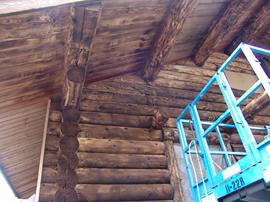 |
| BEFORE |
|
|
|
 |
| AFTER |
|
|
|
Dry Ice Blasting is quickly becoming a preferred cleaning method for fire damage to steel and concrete superstructures, floor and ceiling bar joists, decking, and interior or exterior masonry surfaces. Smoke, soot, vaporized synthetic resins, and char can be blasted off with no net increase of waste material or increased water damage.
Dry Ice Blasting can also remove smoke, charring and ash from wood in preparation for encapsulation, provided that engineers have verified the structural integrity of those construction components.
Easily remove smoke and soot from wiring, junction boxes, power panels, ductwork, and plumbing. Dry Ice blasting is safe for cleaning electrical system components including motor control centers, power distribution panels, transformers, service entrance/metering panels and buss ducts. In some cases, electrical equipment can be cleaned while energized.
|
Dry Ice blasting provides fast and efficient removal of smoke damage, even in the tight angles of trusses, around nails, wiring and all plumbing without damage to the surface integrity.
The Dry Ice blasting process can eliminate or significantly reduce the odor that is left behind by fire damage. Typically, 24 hours after blasting, the odor is undetectable. This means that the use of encapsulation can be drastically reduced in fire restoration. Dry Ice blasting provides a cleaning that the other methods simply can not match.
|
|
In addition, the process has no secondary waste stream. So, when you are done cleaning, there is no need to go back and clean up the added mess other blasting medias, such as soda, water and sand, can leave behind.
Benefits of Dry Ice Blast Cleaning
-
Avoids the mess of soda or sand blasting.
-
Avoids the use of caustics and acids and the liabilities associated with chemical cleaning.
-
Reduces the musty, burnt smell from fire and / or water damage.
-
Eliminates secondary waste streams.
-
Causes no additional water damage.
-
Is safe for cleaning electrical components.
-
Cleans without the surface erosion and etching caused by typical abrasive blasting.
|
|